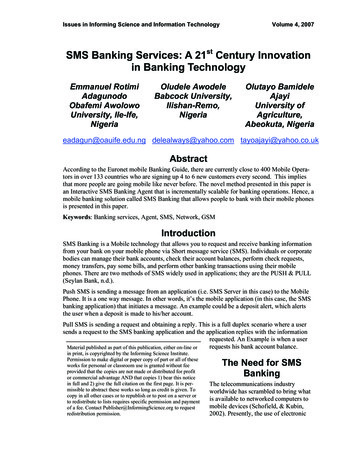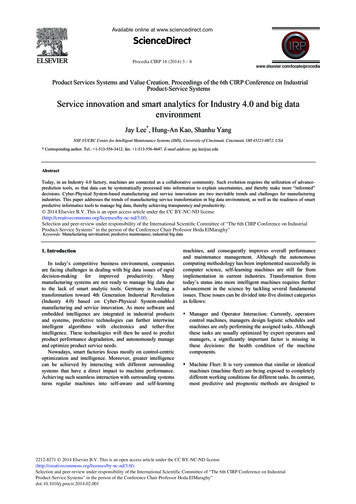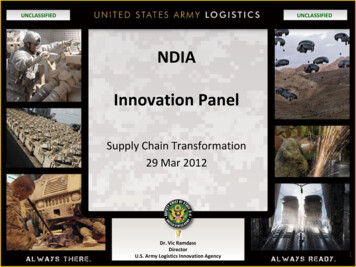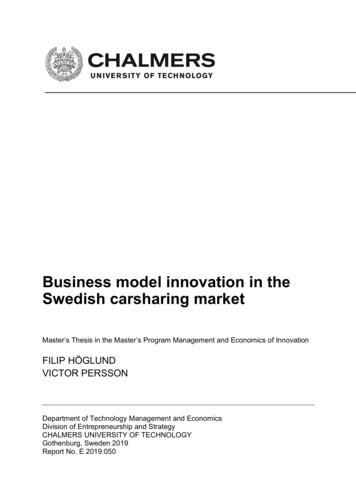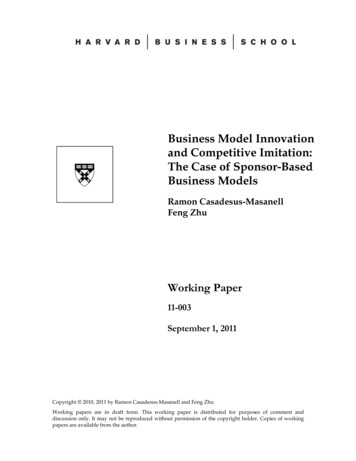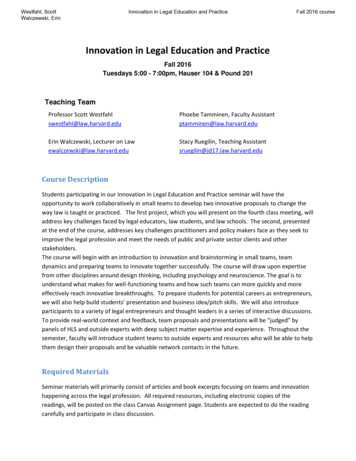
Transcription
CommercializingInnovationTurningTechnology Breakthroughsinto Products―Jerry Schaufeld
CommercializingInnovationTurning Technology Breakthroughsinto ProductsJerry Schaufeld
Commercializing Innovation: Turning Technology Breakthroughs into ProductsCopyright 2015 by Jerry SchaufeldThis work is subject to copyright. All rights are reserved by the Publisher, whether the whole or partof the material is concerned, specifically the rights of translation, reprinting, reuse of illustrations,recitation, broadcasting, reproduction on microfilms or in any other physical way, and transmissionor information storage and retrieval, electronic adaptation, computer software, or by similar ordissimilar methodology now known or hereafter developed. Exempted from this legal reservation arebrief excerpts in connection with reviews or scholarly analysis or material supplied specifically for thepurpose of being entered and executed on a computer system, for exclusive use by the purchaser ofthe work. Duplication of this publication or parts thereof is permitted only under the provisions of theCopyright Law of the Publisher’s location, in its current version, and permission for use must alwaysbe obtained from Springer. Permissions for use may be obtained through RightsLink at the CopyrightClearance Center. Violations are liable to prosecution under the respective Copyright Law.ISBN-13 (pbk): 978-1-4302-6352-4ISBN-13 (electronic): 978-1-4302-6353-1Trademarked names, logos, and images may appear in this book. Rather than use a trademarksymbol with every occurrence of a trademarked name, logo, or image we use the names, logos, andimages only in an editorial fashion and to the benefit of the trademark owner, with no intention ofinfringement of the trademark.The use in this publication of trade names, trademarks, service marks, and similar terms, even if theyare not identified as such, is not to be taken as an expression of opinion as to whether or not they aresubject to proprietary rights.While the advice and information in this book are believed to be true and accurate at the date ofpublication, neither the authors nor the editors nor the publisher can accept any legal responsibilityfor any errors or omissions that may be made. The publisher makes no warranty, express or implied,with respect to the material contained herein.Managing Director: Welmoed SpahrAcquisitions Editor: Robert HutchinsonDevelopmental Editor: Matthew MoodieEditorial Board: Steve Anglin, Mark Beckner, Gary Cornell, Louise Corrigan, James DeWolf,Jonathan Gennick, Robert Hutchinson, Celestin Suresh John, Michelle Lowman,James Markham, Susan McDermott, Matthew Moodie, Jeffrey Pepper, Douglas Pundick,Ben Renow-Clarke, Gwenan Spearing, Matt Wade, Steve WeissCoordinating Editor: Rita FernandoCopy Editor: Kezia EndsleyCompositor: SPi GlobalIndexer: SPi GlobalDistributed to the book trade worldwide by Springer Science Business Media New York,233 Spring Street, 6th Floor, New York, NY 10013. Phone 1-800-SPRINGER, fax (201) 348-4505, e-mailorders-ny@springer-sbm.com, or visit www.springeronline.com. Apress Media, LLC is a CaliforniaLLC and the sole member (owner) is Springer Science Business Media Finance Inc (SSBM FinanceInc). SSBM Finance Inc is a Delaware corporation.For information on translations, please e-mail rights@apress.com, or visit www.apress.com.Apress and friends of ED books may be purchased in bulk for academic, corporate, or promotionaluse. eBook versions and licenses are also available for most titles. For more information, reference ourSpecial Bulk Sales–eBook Licensing web page at www.apress.com/bulk-sales.Any source code or other supplementary materials referenced by the author in this text is available toreaders at www.apress.com. For detailed information about how to locate your book’s source code, goto www.apress.com/source-code/.
Apress Business:The Unbiased Source of BusinessInformationApress business books provide essential information and practical advice,each written for practitioners by recognized experts. Busy managers andprofessionals in all areas of the business world—and at all levels of technicalsophistication—look to our books for the actionable ideas and tools theyneed to solve problems, update and enhance their professional skills, maketheir work lives easier, and capitalize on opportunity.Whatever the topic on the business spectrum—entrepreneurship, finance,sales, marketing, management, regulation, information technology, amongothers—Apress has been praised for providing the objective information andunbiased advice you need to excel in your daily work life. Our authors have noaxes to grind; they understand they have one job only—to deliver up-to-date,accurate information simply, concisely, and with deep insight that addressesthe real needs of our readers.It is increasingly hard to find information—whether in the news media,on the Internet, and now all too often in books—that is even-handed andhas your best interests at heart. We therefore hope that you enjoy thisbook, which has been carefully crafted to meet our standards of quality andunbiased coverage.We are always interested in your feedback or ideas for new titles. Perhapsyou’d even like to write a book yourself. Whatever the case, reach out to usat editorial@apress.com and an editor will respond swiftly. Incidentally, atthe back of this book, you will find a list of useful related titles. Please visitus at www.apress.com to sign up for newsletters and discounts on futurepurchases.The Apress Business Team
This book is dedicated to entrepreneurs who havesucceeded and those who failed. Their experiencesprovide the joy of learning and the opportunityto improve.
ContentsAbout the Author ixAcknowledgments xiIntroduction xiiiChapter 1:Technology Commercialization 1Chapter 2:The Commercialization Model 17Chapter 3: The Sources of Ideas for Commercialization:Are There Enough? 31Chapter 4: Winnowing Down: The Challenge of OpportunityRecognition 53Chapter 5:Feasibility Analysis 63Chapter 6:The Project Plan 75Chapter 7:To Market or Not 85Chapter 8:The Numbers 101Chapter 9: Organizational Dynamics 117Chapter 10: ROI: Does It Make Sense? 129Chapter 11: Big Brother and Global Competition 147Chapter 12: Looking Forward 161Appendix A: Sample US Patent 177Index 187
About the AuthorJerry Schaufeld’s wealth of experience inentrepreneurship, operations, and generalmanagement of technology-based companiesranges from his current role as ization at Worcester PolytechnicInstitute (WPI) to an assignment as a consultantat the technology transfer interface of Children’sHospital in Boston.He served as Director of the RI Slater Fund,(a state-level investment resource for earlystage companies), was President and CEOof Mass Ventures (a quasi-public technologyincubator), and has a “hands-on” track recordsranging from functional to board-level advisory roles in several early-stagecompanies. He is a founding member of the Launchpad Angel Group inWellesley and co-founder of the Cherrystone Angels in Rhode Island. Inaddition, Mr. Schaufeld is an advisor to the Boynton Angel Group in CentralMassachusetts, a charter member of the national Angel Capital Association(ACA), and a founder/participant in the regional NE Angels ACA group.Mr. Schaufeld was a founder and the first Chairman of the MIT EnterpriseForum, which now has 23 chapters around the world. He also founded the IncusGroup, which is a CEO-level business acquisition and resource collaboration.Mr. Schaufeld was co-founder and COO of Phoenix Controls Corporation.The company pioneered an approach to the control of air flow in criticallaboratory and hospital environments. After ten operational years, it wassuccessfully sold to a Fortune 500 company.With a graduate engineering degree, research experience at MIT, an MBA, aprofessional engineer’s license, and a Professional Board Director’s Certificate,Mr. Schaufeld has a distinguished technical and operations-savvy managerialcareer. His current interest and research is in the area of improving theprobability of success of early stage, innovative, technology-based ventures intheir quest for commercializing innovative opportunities.
AcknowledgmentsThe complete list of important people is long. Some of the special folks whohelped with the journey of creating this text include: Professor Ed Roberts at the MIT Sloan School ofManagement, whose unabashed enthusiasm for reportingon his research on MIT spin-off companies and entrepreneurship set the classroom stage that helped enable mycareer in early stage ventures. Art Parthe (deceased), co-founder of the MIT EnterpriseForum and Engineering Group Leader at Draper. His utterbelief in “can do” set the pace for astonishing accomplishments that finally led to the development of flight-controlsystems capable of landing a man on the moon. Bob McCray, founder of Worcester Controls and formerDirector of my company, Phoenix Controls. Our manydiscussions about integrity and how the forces of growthare connected to the corporate lifecycle phenomenawere absolutely invaluable. Rico Baldegger, colleague and Director of the School ofBusiness (HEG) in Fribourg, Switzerland, who not onlyfurthered my appreciation the unique Swiss perspectivebut also opened my view of the role of global competition. Mac Banks, former Director of the WPI School ofManagement, who 10 years ago took the risk of hiring meas an unknown entrepreneurship academic and providedincredible support for a new and exciting career. WPI’s Professor Diran Apelian has provided an impressive and awesome example of what can be accomplishedat the intersection of theory and practice in his stewardship of the WPI Materials Processing Institute. It has setan example of applied academic leadership for which mycolleagues and I are grateful.
xiiAcknowledgments The fourth grade teachers in the Houghton ElementarySchool in Sterling, Mass. Not only did they show me theimportance of teaching excellence and integrity, but theyalso demonstrated the value of instilling learning skills inthe early years.That certainly includes the basis for teaching entrepreneurship awareness in the early grades that’snow in vogue.Thank you to my friends, family, and colleagues, whose endless and politeinquiries about the progress of this book helped. Their interest and attentionwere certainly appreciated.Special thanks to my wife Sue, whose continuous support (and cajoling energy)for this project was crucial. It would not have seen completion without it.Thanks also to those special folks at Apress. Jeff Olson the former editor whobelieved in the topic and helped the publishing cycle start. Robert Hutchinson,who later carried the project to the finish line.Very special thanks to Rita Fernando, of Apress, New York, whose saint-likepatience and energy to my endless tactical questions is really the force thatdrove it all to a final iteration. Finally, thanks to Matthew Moodie who joinedthe team late in the game, but whose help is appreciated.
IntroductionWe live in a time of unprecedented attention to the forces of innovationand entrepreneurship. Throughout the world, the combination of these twofocused efforts affords us the opportunity to both compete and profit on aglobal basis. To enable this, the technology that allows us to benefit and thechannels of information that can communicate these ideas to those who canutilize them, are both changing at warp speed.Within this dramatic environment, the processes for improving the probabilityof commercial success of these ideas lags behind. This book offers a modelfor increasing the odds as well as the narrative that supports it. Much of thework presented is derived from a graduate course I teach in the WorcesterPolytechnic Institute (WPI) School of Business entitled “TechnologyCommercialization.”Rapid change affords opportunities we could only have imagined a few yearsago. The drama of the change in “technology commercialization” is awesome.New models of nimble and adaptive thinking anchored in solid businessfundamentals are required to realize its benefits.
Chapter1TechnologyCommercializationThe LegacyWe live in a time of incredible technological change. It is characterized bysignificant dislocations of people, political infrastructures, capital formation,and material resources. It is fueled by significant investments in innovationand entrepreneurship at levels of public and private funding. The dimensionsare global and empowered by enabling forces such as the Internet, Facebook,Twitter, Google, and a seemingly endless list of social media-based design andcommunication tools. They use a new vocabulary that enables rapid and international levels of collaboration. The implications of all this are just
Schaufeld Commercializing Innovation www.apress.com Turning Technology Breakthroughs into Products

